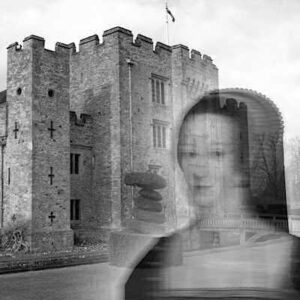 Thanks to Anne Boleyn Files visitor Nancy Smith for writing this great article on the ghost (or ghosts!) of Anne Boleyn – I love a good ghost story!
Thanks to Anne Boleyn Files visitor Nancy Smith for writing this great article on the ghost (or ghosts!) of Anne Boleyn – I love a good ghost story!
“With Her Head Tucked Underneath Her Arm and Other Tales of the Ghostly Anne Boleyn”
If legends are true, Anne Boleyn’s ghost must be the most traveled ghost in Britain – if not in the whole world! In researching Anne’s afterlife, I have found at least seven locations where her spirit is said to walk:
- Hever Castle, her childhood home
- Blickling Hall, her alleged birthplace
- The Tower of London, where she was executed
- Hampton Court Palace and Windsor Castle, where Anne and Henry resided during their marriage
- Salle Church in Norfolk, where Anne’s body was allegedly moved after her original burial in the Chapel of St Peter ad Vincula in the Tower of London and secretly buried under a black slab near the tombs of her Boleyn ancestors
- Marwell Hall in Hampshire, a residence of the Seymours between 1530-1638.
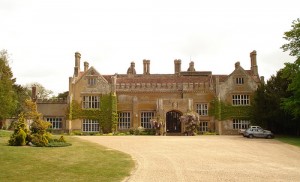
Marwell Hall - photo by davidhc on flickr Salle Church and Marwell Hall
I’ll start with the stories about which I could find the least information. I was unable to find any specific ghost stories relating to Salle Church, and the only story I could find about Marwell Hall is that she haunts YewTree Walk, where Henry VIII and Jane Seymour are rumored to have strolled while planning their wedding. Legend has it that Henry and Jane were at Marwell Hall while Anne was in the Tower awaiting execution, and that Henry had arranged for a chain of beacons to let him know that the execution had taken place. It has also been rumored that Henry first married Jane at Marwell Hall on May 19 (the day of Anne’s execution!) before their official wedding on May 30, 1536.
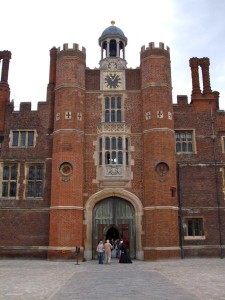
Hampton Court Palace - photo by Paudie Kennelly Hampton Court Palace and Windsor Castle
Anne also haunts two of the most famous royal residences in southern England – Hampton Court Palace and Windsor Castle. At Hampton Court she is seen wearing a blue dress. She has been described as walking slowly, with a sad countenance. One wonders if she ever encounters her successor, Jane Seymour, who died at Hampton Court on October 24, 1537, 12 days after giving birth to Prince Edward. Jane has been seen in the Clock Court and in the Silver Stick Gallery, wearing a white robe and holding a lit candle. Anne might also encounter the spectre of her first cousin, Henry’s fifth wife, Queen Katherine Howard, as she meanders the halls of Hampton Court. Following her arrest , Katherine allegedly broke free from her guards and ran towards the door of the Chapel, where Henry was at prayer, in hopes that if she could appeal to him in person, Henry would pardon her. Henry ignored her pleas, and Katherine was dragged struggling and screaming back to her rooms. The corridor through which she ran is now called the Haunted Gallery, and Katherine’s ghost can still be seen and heard running down the corridor, still pleading for mercy.
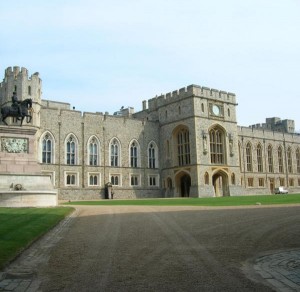
Windsor Castle At Windsor Castle, Anne’s ghost has been seen standing at a window in the Dean’s Cloister. If stories are true, the hauntings at Windsor Castle may be a (dysfunctional) family affair. Henry also allegedly haunts Windsor, and one wonders what they might say to each other if they were ever to meet. Castle guests have heard Henry’s footsteps echo along the corridors of the castle, and have heard him moaning and groaning as he attempts to pull his ulcerated leg along behind him. Henry’s and Anne’s daughter, Queen Elizabeth I, has been seen by several members of the royal family haunting the Royal Library. Sounds of her high heels are heard on the bare floorboards before her figure appears and passes through the library and into an inner room. She has also been seen standing at a window in the Dean’s Cloister, wearing a black dress with a black lace shaw draped over her shoulders. Since Anne has also been seen in the Dean’s Cloister, perhaps mother and daughter have been able to forge the relationship that they were denied in life in the afterlife. One certainly hopes so.
Now I’ll tell the stories that relate to the places that had the greatest effect on Anne during her lifetime, either because of the happy times she enjoyed there, or because of the traumatic associations she has with them.
Blickling Hall
To start at the beginning, Blickling Hall in Norfolk is the place where many modern historians believe to be Anne’s birthplace. The present building, built in the early 17th century, for Sir Henry Hobart, stands on the site of a previous building that belonged to Anne’s father, Sir Thomas Boleyn. On May 19, the anniversary of her death, Anne is said to return to Blickling Hall. A carriage comes up the drive leading to the hall, drawn by six headless horses and driven by a headless coachman. Anne sits inside, dressed in white and holding her severed head in her lap. When the carriage reaches the front doors, the horses and carriage disappear and Anne goes inside to roam the halls until daybreak.
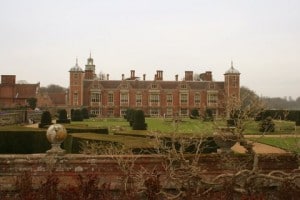
Blickling Hall Also on May 19 her brother, George Boleyn, Lord Rochford, is seen being dragged across the countryside by four headless horses. His headless ghost has also been seen wandering the grounds of the estate, searching for peace and justice. Blickling Hall is also said to be haunted by their father, Sir Thomas Boleyn. Some say he is the driver of the coach that delivers Anne to Blickling Hall on the anniversary of her execution. After dropping Anne off at the front doors at midnight, Sir Thomas continues on, pursued by hoards of screaming demons cursing him for his betrayal of his family. He is forced to drive his spectral coach over 12 bridges that lie between Wroxham and Blickling for 1,000 years as penance.
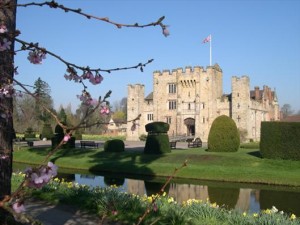
Hever Castle Hever Castle
Hever Castle, Anne’s childhood home, came to be in 1272, when Sir Stephen de Penchester was granted permission from Edward I to convert his house at Hever into a castle. The Boleyns purchased the castle in the early 16th century, rebuilding much of the castle and erecting a comfortable Tudor residence within its walls. Henry VIII was rumored to have courted Anne beneath the great oak, which is still standing. The hauntings at Hever Castle are not nearly as macabre as those at Blickling Hall. Anne loved Hever, so perhaps she returns there for peace, and to contemplate the happiness that she once knew there. Every Christmas Eve she has been seen crossing the bridge over the River Eden in the castle grounds. She has also been seen standing beneath the great oak, under which Henry wooed her.
The Tower of London
The final, and by far most active of the places that Anne allegedly haunts is the Tower of London, the place of her execution. If ghosts are, as some believe, surviving emotional memories typical of one who has died violently, traumatically and tragically, as Anne did, then it is very understandable that some essence of her remains at the Tower. The main fortress of the Tower, known as the White Tower, was begun by William the Conqueror in 1078 and added onto by subsequent monarchs, so the Tower was already over 450 years old when Anne became queen. Since the Tower was a place of imprisonment and death for most of its existence, as well as a royal residence, it is said to be the most haunted building in London, if not the whole of England.
Anne Boleyn’s ghost has been seen in several places around the Tower grounds – in the White Tower, the Queen’s House, where she allegedly stayed the night before he coronation and also during her imprisonment prior to her execution (Claire’s excellent article about Anne and the Tower proves that this is a fallacy – see Anne Boleyn and the Tower of London); Tower Green, site of the scaffold; and the Chapel of St. Peter ad Vincula, where she was buried under the floor of the chancel in an arrow case.
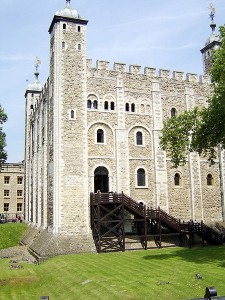
The White Tower In 1817 a sentry patrolling the White Tower suffered a fatal heart attack after encountering a ghostly Anne Boleyn on a staircase. In 1864 a sentry standing guard outside of the Queen’s House reported seeing the white figure of a woman veiled in mist. She was wearing Tudor dress and a French hood; however, where her face should have been there was nothing. He challenged the figure and when it did not reply and continued towards him, the sentry made a thrust at it with his bayonet. What happened next caused him to swoon – his bayonet passed through the figure, and a firey flash ran up his rifle and gave him a shock. The sentry was court-martialed for falling asleep during his watch. He was found not guilty when several eyewitnesses told the court that they had also seen the headless woman on Tower Green that night. One officer who saw the event from a window in the Bloody Tower testified that he had heard the sentry yelling at the figure to stop, and then saw him thrusting his bayonet through it. He saw the figure pass through the bayonet and then through the sentry as well.
By far the most spectacular haunting by Anne in the Tower takes place in the Chapel Royal of St Peter ad Vincula, where she is buried. In the late 19th century, a Captain of the Guard noticed a light burning in the locked chapel late at night. Upon finding a ladder and placing it against one of the chapel windows, he was shocked at the scene taking place in the otherwise “empty” chapel. It can best be described by an excerpt from Ghostly Visitors by “Spectre Stricken”, London 1882:
“Slowly down the aisle moved a stately procession of Knights and Ladies, attired in ancient costumes; and in front walked an elegant female whose face was averted from him, but whose figure greatly resembled the one he had seen in reputed portraits of Anne Boleyn. After having repeatedly paced the chapel, the entire procession together with the light disappeared.”
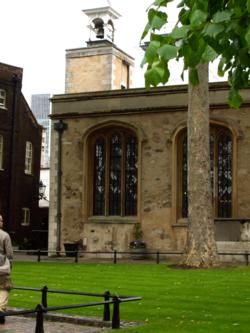
Chapel of St Peter ad Vincula - Photo by Paudie Kennelly by Nancy Smith
Thanks for a wonderful article, Nancy!
With Her Head Tucked Underneath Her Arm
Nancy’s article title “With Her Head Tucked Underneath Her Arm” refers to a song about Anne Boleyn’s ghost, written by R P Weston and Bert Lee in 1934 and performed by Stanley Holloway. Here are the lyrics:-
In the Tower of London, large as life,
The ghost of Ann Boleyn walks, they declare.
Poor Ann Boleyn was once King Henry’s wife –
Until he made the headsman bob her hair!
Ah yes! he did her wrong long years ago
And she comes up at night to tell him so.
[With her head tucked underneath her arm
She walks the Bloody Tower!
With her head tucked underneath her arm
At the midnight hour…]
She comes to haunt King Henry,
She means giving him what for,
Gadzooks, she’s going to tell him off for having spilt her gore,
And just in case the headsman wants to give her an encore
She has her head tucked underneath her arm!
[Chorus]
Along the draughty corridors for miles and miles she goes,
She often catches cold, poor thing, it’s cold there when it blows,
And it’s awfully awkward for the Queen to have to blow her nose
With her head tucked underneath her arm!
Sometimes gay King Henry gives a spread
For all his gals and pals – a ghostly crew.
The headsman carves the joint and cuts the bread,
Then in comes Ann Boleyn to queer the do;
She holds her head up with a wild ‘Wahoop!”,
And Henry cries ‘Don’t drop it in the soup!’
[Chorus]
The sentries think that it’s a football that she carries in,
And when they’ve had a few they shout ‘Is Ars’nal going to win?’
They think it’s Alec James, instead of poor old Ann Boleyn
With her head tucked underneath her arm!
[Chorus]
One night she caught King Henry, he was in the canteen bar,
Said he ‘Are you Jane Seymour, Ann Boleyn or Cath’rine Parr?
For how the sweet san fairy ann do I know who you are
With your head tucked underneath your arm!’
(Source: Wikipedia)
Videos
In the following video on ghost stories from the Tower of London there are some great clips of the Tower of London but Anne was never imprisoned in the Queen’s House (built in the 1540s) and there is no evidence that she had 6 fingers and 6 toes or that she was ” a peculiar woman”! This is what we’re up against!!
And here’s one of the Hampton Court Palace ghosts:-
What do you think?
Sources for Nancy’s Article
Wikipedia – Anne Boleyn
The Shadowlands: Famous Hauntings – The Haunting of Hampton Court Palace
Windsor Castle – Ghost Stories, Ghost Sightings and Haunted History
Quest for Ghosts – Blickling Hall, Blickling, Norfolk
Ghost Story – The Ghost of Anne Boleyn
Information Britain – Blickling’s Boleyn Bedevilment
The Culpepper Family History Site – Hever, Kent – Hever Castle’s “Haunted House Story”
The Red Pill – Ghost of Anne Boleyn
Mysterious Britain & Ireland – The Tower of London
Paranormal – The Traveling Ghost of the Headless Witch: Anne Boleyn by Patrick Bernauw, published 2/17/09
Camelot International – The Tower of London – The Ghost of Anne Boleyn
Tower Ghosts – Tower of London – Icons of England
Hampshire Legends, Ghosts and Apparitions